Module 3
1. Module 3
1.21. Page 2
Module 3—The Male and Female Reproductive Systems
 Explore
Explore
You may choose to do either the Read or the Watch and Listen activity. As you review the material about STIs, pay particular attention to the effects they can have on the reproductive structures and their functions. The video provides a general overview while the reading is more detailed. As you choose to complete the reading or watch the video, begin the Try This activity. The completed table will become your notes about STIs.
 Try This
Try This
Complete the table about sexually transmitted infections. The first row has been completed as an example.
 Read
Read
Sexually transmitted infections have plagued humans for thousands of years. They can affect anyone at any time regardless of gender, age, race, wealth, religion, or culture. In order to make informed choices regarding your reproductive health, you must be aware of the main causes and effects for the most common STIs.
This lesson will only address seven of the most common, serious, and rapidly spreading STIs. There are many other STIs, cancers, and other reproductive disorders that can affect fertility.
Read “Effect of STIs on the Reproductive Systems” on pages 486 to 490 in the textbook.
 Watch and Listen
Watch and Listen
Watch the video “Reproductive Technologies and Sexually Transmitted Diseases: Eggs, Embryos, and Ethics” to learn more about the causes, signs and symptoms, transmission, consequences, and treatments of some of the more common sexually transmitted infections.
 Self-Check
Self-Check
SC 1. Examine the following graphs detailing infection rates of certain STIs by age group in Alberta. For each graph, write an interpretation of the data presented by examining the age group and rate of infection.
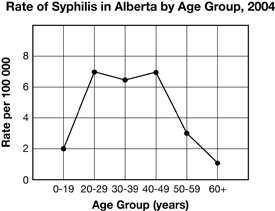
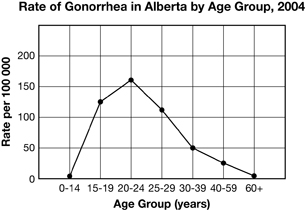
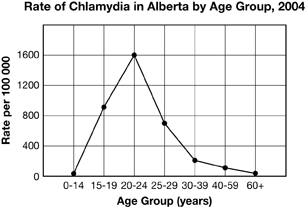
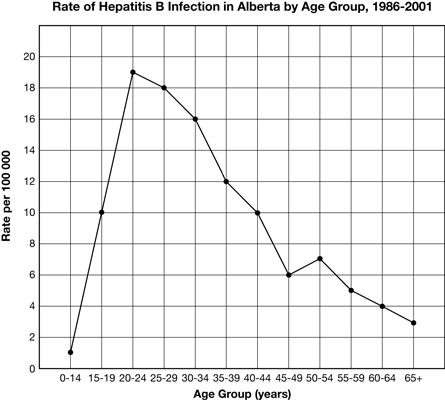
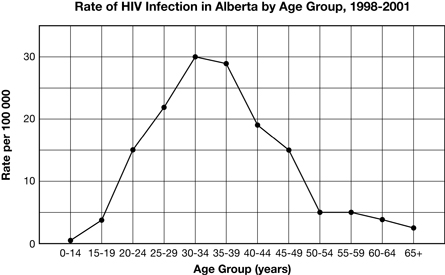
 Self-Check Answers
Self-Check Answers
SC 1.
Rate of Syphilis Graph: Syphilis infection predominantly affects individuals who are 20 to 49 years of age. However, the incidence of syphilis is low compared to other sexually transmitted infections.
Rate of Gonorrhea Graph: Gonorrhea infection is highest among the 20 to 24 age group, but the 15 to 19 and 25 to 29 age groups also have a relatively high rate of infection.
Rate of Chlamydia Graph: The rate of chlamydia infection is very high among the 20 to 24 age group. The rate of infection among the 15 to 19 age group and the 25 to 29 age group is nearly half that of the 20 to 24 age group, but is still very high compared with other sexually transmitted infections.
Rate of Hepatitis B Graph: The rate of hepatitis B infection rises dramatically from the 0 to 14 age group and the 20 to 24 age group. It decreases gradually from age 25 to 65+, with a slight increase in the 50 to 54 age group.
Rate of HIV Infection Graph: HIV infection is highest among the 30 to 39 age group. It is less common than chlamydia and gonorrhea among this age group. Individuals aged 0 to 19 and 50 to 65+ have a relatively low rate of HIV infection.
 Discuss
Discuss
Although STIs can be a difficult topic to discuss, it is important to make sure you have a good understanding of what they are and how they are transmitted. Use the discussion area of your class to discuss one, some, or all of the following questions.
D 1. Why is it so difficult for teens and young adults to believe they can acquire an STI?
D 2. How would you get the message of the seriousness of STIs across to young people?
D 3. If a person tests positive for an STI, should health agencies have the right and responsibility to inform the individual’s sexual partners? Why or why not?
D 4. Can the use of a condom prevent all STIs?
 Self-Check
Self-Check
SC 2. See how well you understand STIs by completing “Section 14.2” questions 1 to 6 on page 491 of the textbook.
 Self-Check Answers
Self-Check Answers
“Section 14.2 Review” Answers
1. Examples of Viral and Bacterial STIs
| Viral STIs | Bacterial STIs |
| HIV/AIDS | chlamydia |
| hepatitis (A, B, and C) | gonorrhea |
| genital herpes | syphilis |
| HPV |
2. PID (pelvic inflammatory disease) is a disease that occurs in women; it is caused by undetected chlamydia that has spread to the cervix and oviducts. PID is painful and can lead to the buildup of scar tissue in the oviducts and open sores on the cervix. This may lead to infertility (oviduct damage) and/or an increased risk of acquiring HIV. Chlamydia and PID also pose risks to babies who come into contact with the disease during birth, including potential respiratory infections and eye infections. PID can also arise if gonorrhea goes untreated.
3. A woman who is infected with an STI can present numerous risks to her baby. Diseases can be passed to the baby through the placenta (e.g., HIV, hepatitis B), during birth (e.g., HIV, genital herpes, chlamydia, gonorrhea), and through breast milk (e.g., HIV).
4. a) A person who is infected with an STI but does not present any symptoms will not visit a doctor for treatment. While they wait, the infection may become more serious, progressing to PID, infections, cancer of the cervix (women), tumors on the vulva, vagina, anus or penis, or infertility.
b) The public health risk of the asymptomatic individual infected with an STI is that they may unknowingly infect other people if they engage in unsafe sex practices or, in the case of pregnant women, pass the STI to their babies.
5. Look for the following key points: Both viral and bacterial STIs have health consequences, the severity of which increases as the infection progresses untreated, and depending on the type of infection. It is true that the viral infections cannot be cured, only managed, and there is a high likelihood that death will result with some viral infections (HIV and hepatitis) or that cancer may develop (HPV). Bacterial infections, while curable, are more likely to go undetected, increasing the possibility that they will be spread unknowingly, as well as the possibility that they won't be detected until they have progressed to the more damaging PID, which can cause scarring and infertility, or infect a baby during birth. In addition, many bacterial diseases are becoming resistant to current antibiotics. The consequences of either form of STI make it preferable to avoid both.
6. a) Points supporting the teaching of abstinence: abstinence (from oral, anal, and vaginal sex, and the sharing of needles) is the only way to guarantee the prevention of transmission of STIs. Points supporting the teaching of safe sex practices: students may argue that individuals will engage in sexual practices so it is better to be educated about safe sex practices to avoid transmission of STIs (as well as unwanted pregnancies). Students can evaluate the arguments from an individual point of view, a societal point of view, or even a government viewpoint. It is in the best interest of society and government to teach people about the effects and transmission of STIs so that healthcare does not have to deal with large volumes of transmissions.
b) Health practitioners can design education campaigns that respect the views of those advocating abstinence and safe sex practices by presenting the facts of each and allowing the recipients of the information to make their own decision. This can be done by avoiding nuanced language or judgmental, subjective conclusions.
Inquiry into Biology TRG (Whitby, ON: McGraw-Hill Ryerson, 2007), Sec 14.2 Reproduced by permission.
viral STIs: examples are HIV, HPV, and hepatitis; more problematic, possibly incurable because they cannot be treated with antibiotics
bacterial STIs: examples are gonorrhea, syphilis, and chlamydia; can be treated with antibiotics
asymptomatic infection: infection that is present but the affected person does not experience symptoms
abstinence: not having sexual intercourse
safe sex: the use of a barrier, such as a condom, during sex to prevent transmission of infection